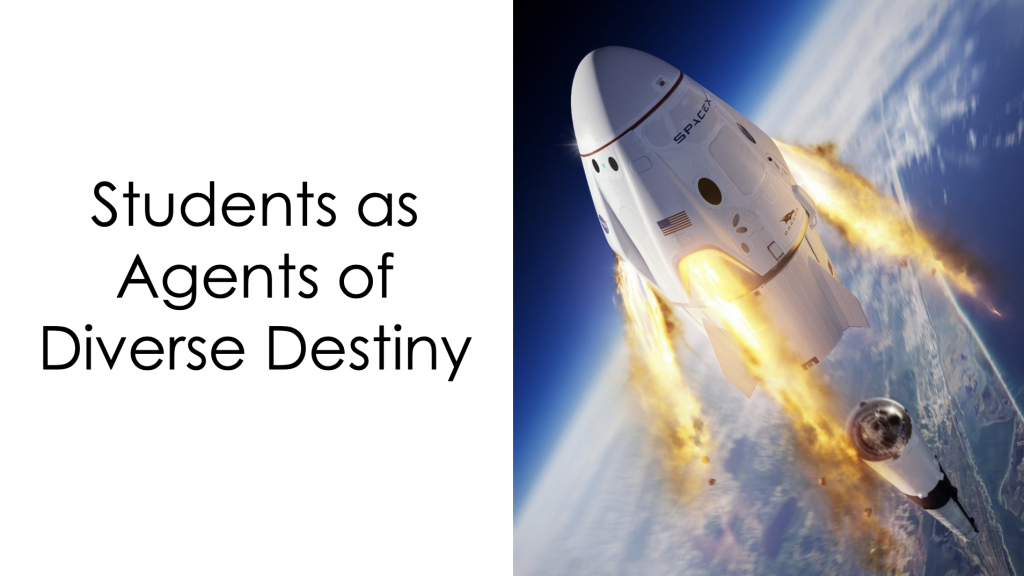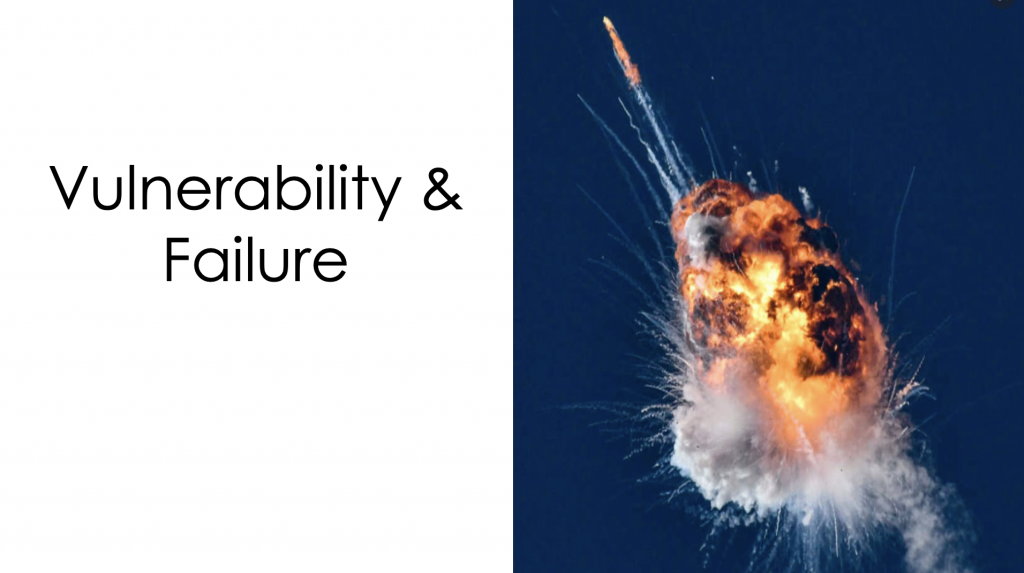Module 2: Students as Agents of Their Own Diverse Destiny: Vulnerability and Failure
![]()
Figure 1: Students as Agents of Diverse Destiny Trailer
Click here for a version with ASL
Click here for a version with LSQ (coming soon!)
Story
Objective: To help all members of an institution support students in becoming self-guided experts in their own diverse, life-long learning path. To address current and emerging demands, students must differentiate themselves and continue learning throughout life, all while acknowledging that diversity is our society’s most valuable asset. This implies rethinking notions of student conformance to singular institutional standards, biased exclusionary recruitment, systems of preferential academic ranking and promotion, reductionist assessment techniques, student surveillance and policing, and winner-takes-all competition, among other academic conventions. How do we equip students to value, develop, and apply their own unique contributions throughout life?

Figure 2: Alice Donovan Rouse on Unsplash
Students have ownership over their own path and how they get there. To humanize this path, we need to release the hold that traditional academia has on learning, shift responsibility and power back to the student, and give them true ownership over their decisions and metrics for “success.” Here, we use “power” to mean having the capacity and ability to cause change in behaviours/systems/lives of people. Shifting the balance of power in educational relationships is at the core of humanizing learning.
As instructors, we need to ask ourselves: How do we interact with students? Are students given choice and agency in showing their learning? How can we give students more control in their learning? How do we humanize our practice to ultimately serve students better? How can we model the importance of vulnerability and trust to our students?
There is great value and meaning in genuine displays of vulnerability. From true vulnerability, we can grow trust and personal connections with our students. We can open up perspectives and dialogues that lead to meaning-making. How as instructors can we do this? How can we model vulnerability when we ourselves might be in a position of precarity?
To get at the roots of these issues, several framing questions were asked of the co-design participants in this module:
- How do you see the relationship between vulnerability, failure, and student agency?
- Where has failure been an important learning opportunity for you and/or your students?
- What does vulnerability mean in a teaching and learning setting?
- What scares you most about the vulnerability/failure/student agency trinity?
Session Topic Introduction: Students as Agents of Their Own Diverse Destiny
Figure 3: Terry Greene’s Gettin’ Air OnHumanLearn Podcast
Week 3: Students as Agents of Diverse Destiny
Keywords for the week: Vulnerability and Failure
In preparation for this week:
- Listen to this seventeen-minute podcast to hear the facilitators’ intro for this topic: https://www.spreaker.com/user/voicedradio/onhumanlearn
- Greene, Terry, host. “The #OnHumanLearn Module Two Team.” Gettin’ Air, 2021, https://www.spreaker.com/user/voicedradio/onhumanlearn.
Optionally, skim these articles for extra context:
- Train Wrecks: 3M National Teaching Fellows Explore Creating Learning and Generative Responses from Colossal Failures
- Strean, William Ben, et al. “Train Wrecks: 3M National Teaching Fellows Explore Creating Learning and Generative Responses from Colossal Failures.” Collected Essays on Learning and Teaching, 2019, https://celt.uwindsor.ca/index.php/CELT/article/view/5295.
- Learner Agency and the Learner-Centred Theories for Online Networked Learning and Learning Ecologies
- Blaschke, Lisa Marie, et al. “Learner Agency and the Learner-Centred Theories for Online Networked Learning and Learning Ecologies.” Unleashing the Power of Learner Agency, EdTech Books, 1 Jan. 1970, https://edtechbooks.org/up/ecol.
Findings from Week 1: “What?” and “So What?”
How do you see the relationship between vulnerability, failure, and student agency?
- Failure and reflection can deepen both learning and engagement.
- Typically, control rests with the teacher, and only the teacher gets to set the classroom tone and make decisions.
- This relationship may vary by discipline, e.g., science (learning from experimental failure), engineering (learning from structural failure), business (fail fast, fail often), pharmacy (learning from prescription errors).
- Who is allowed to actually be vulnerable? Precarity and background and associated measures of privilege, or lack there of, can make vulnerability more risky. Folks from under-represented groups may face more consequences for vulnerability.
- Failure is a core component of the learning process, and yet we don’t teach students how to embrace and learn from failure. In fact, we don’t even provide structurally safe spaces for this to happen in.
Where has failure been an important learning opportunity for you and/or your students?
- Demonstrating that experts can and do fail can relieve pressures on students.
- Modelling errors as instructors, and showing how we learn from them, can help reduce the stigma of errors to our students.
- Modelling responses to failure can help students see how to have grace, accept critique and feedback, and accept fallibility.
- Humanizing the relationship to students through being vulnerable.
- Failure reveals what we don’t know, informs the learning journey, and shows that not knowing is normal — we need to figure out what we don’t know so we can focus our learning at the edges of knowing and not knowing.
- Discomfort and learning go hand-in-hand. We learn most when we are uncomfortable, and we need to normalize the feeling of not knowing something, which is inherently uncomfortable.
What does vulnerability mean in a teaching and learning setting?
- Being willing to share your humanity.
- Normalize not knowing. It is easier to model genuine curiosity if vulnerability is accepted.
- Normalizing the struggle … we’re all works in progress.
- Modelling of vulnerability and productive failure is critical.
- Students may be more likely to question and challenge if they know you’re fallible.
- Failure is “baked into” teaching, but we don’t often name it or model it.
What scares you most about the vulnerability/failure/student agency trinity?
- Students may see vulnerability as weakness. Will this cause the teacher to “lose control” of the class? (And isn’t “losing control” part of the process of giving students more agency in their learning journey?)
- Vulnerability comes with risks: e.g., emotional, reputational, and career progression.
- Forgetting what it was like to be a novice; we need to hold space for this as educators
- Imposter syndrome!
- How do we acknowledge existing power and privilege within this discussion on vulnerability and failure? Does everyone actually have access to the same safe spaces for vulnerability?
Findings from Week 2: “Now What?”
The Importance of Embracing Discomfort and Learning from Failure
Learning from failure is a core component of the process of learning, however, it isn’t always actively taught in higher education. It is, in fact, a core component of reflective living, and given that we want our students to have meaningful experiences beyond higher education, modelling learning from failure is crucially important. Learning from failure takes time — it isn’t something that can be rushed — and it is more meaningful when it is accompanied by connection and support. Science of learning tells us that our brains remember things better when we feel a bit uncomfortable, so this discomfort actually helps us learn. There is a valuable place for friction and discomfort alongside our courses, but again only when connections and structural support are in place so that students can have an equitable experience of moving through and beyond failure.
Structural Support for the Vulnerability/Failure/Student Agency Trinity
There is an urgent need to build safe havens for failure. Giving advice to students to “embrace and learn from failure” is hollow if it isn’t accompanied with a safe space to do so. These safe havens would need to have structural support in terms of institutional norms, course policies, tangible instructor support, and shifts in course culture/environment. Examples of institutional changes and structural support could include modifying rigid institutional grading policies or entrance criteria; modification of registrar course re-take policies; increasing TA support to allow for more formative feedback and moments of genuine connection; incorporation of more reflective learning activities into class; and reconsideration of student evaluations of teaching, especially for instructors in a position of precarity.
Emphasizing Connection and Relationships
For this work to occur, there is a need to prioritize relationships and feedback for growth and reflection through failure. Learning is a relational act, and it is through emphasizing student-instructor and student-student relationships that we can start to engage in perspective-taking and acknowledge that we are all works in progress. By centring formative feedback and modelling how to move forward through feedback, instructors can foster a dialogue of feedback and change with students. Another aspect to consider is that of time. This work needs to be done slowly and can’t be rushed according to institutional time scales. Students and instructors alike need the time to dedicate to relationship building and cultures of dialogue and feedback.
The Importance of Modelling the Process and Avoiding Professor Worship
- Building capacity is different from building capability. We as instructors can lay the foundations for encouraging students to learn through failure. We can do this by modelling the process of embracing and learning from our mistakes.
- Keep in mind to “coach people to hold their ideas lightly” and “failed ideas make great compost” (McKercher 2020).
- A common phrase from childhood memories might be that of “practice makes perfect.” We want to propose to replace this with the phrase “practice makes progress.” We need to highlight that we are all working in progress, that we all have flaws, and that these flaws can be celebrated. A sometimes common view of the professor or instructor as a “finished work” or “expert” or “genius” works against idea of works in progress. Hero worship of “genius professors” and the idolatry that comes with this is harmful and needs to be named and avoided. “Cults of professor worship” reinforce the mistaken notion that there are those who are geniuses and those who are not; it reinforces a binary of excellent or not. We can move past this as instructors by modelling learning from errors and sharing narratives of personal reflection and growth. We recognize, however, that this modelling takes place in the broader context of an academic institution with existing norms around definitions of excellence, which reinforces the need for structural changes accompanying this work.
The Power and Privilege of Vulnerability and Failure
- We need to start by acknowledging that power and privilege are everywhere, ever present, and ever changing.
- We need to examine power within these contexts, and specifically ask ourselves questions about power and failure. What power do we have and where did we get it from? How can we use our power to make others feel sale and dismantle power structures themselves? Do all students have equal access to second chances? Do all students have safety nets that allow them to take more risks? Our advice to students to take risks and embrace failure will feel disingenuous if it isn’t accompanied by an acknowledgement of power structures inherent in these spaces.
- Don’t mistake silence for progress or for agreement. How will we recognize when our students are meaningfully engaging with failure? We need to be careful about misinterpreting silences adjacent to vulnerability and failure.
- There is well-documented inequity in who “gets” to fail. Folks from underrepresented groups are often held to higher standards than folks from the dominant group, and there is bias in how society interprets failures by different people. We need to acknowledge this in any discussion of failure and its role in the process of learning.
Links to Session Materials
Plenary Video
Figure 4: Module 2 Plenary: Students as Agents of Diverse Destiny
Click here for a version with ASL
Click here for a version with LSQ (coming soon!)
Humanizing Deck
Slide 1: Students as Agents of Diverse Destiny
Diverse destiny — students have ownership over their own path and how they get there. Releasing the hold that traditional academia has on learning — shifting the responsibility and power back to the student and give them ownership. Reflect on your practice: How often do you interact with students? Within that, are they given choice and agency in showing their learning? How do we humanize our practice to ultimately serve them better? In the academy there is survivorship bias that allows us to favour traditional pathways to success; how do we release these notions of “what works” and shift power and responsibility back to the students?
Slide 2: Vulnerability and Failure
So how does vulnerability and failure foster student agency in an online learning environment?
From vulnerability we grow trust and personal connections with our students. According to Yair, it is these personal connections that lead to “transformational learning moments” (2019). Allowing ourselves to be vulnerable and creating opportunities for students to be vulnerable fosters a growth mindset. Dweck (2016) states that a willingness to accept failure and mistakes as part of the learning process results in overall greater success. So, there is value in attempting new teaching and learning methods; so much so that it outweighs the risk of making mistakes.
One of my favourite quotes in the Train Wreck article, co-authored by our own Pat Maher, is the Failing Well Certificate of Failure from Smith College by Bennett (2017). It reads, “You are hereby authorized to screw up, bomb or fail at one or more relationships, hookups, friendships, texts, exams, extracurriculars or any other choices associated with college … and still be a totally worthy, utterly excellent human.” What if academics and students were given a permission slip to fail? Pat talks about taking that experience and learning from it, rather than turning “it failed” to “I am a failure,” we say it is simply something that didn’t work, I learned from it, and it is going to propel me forward. David Kelly, the CEO of IDEO, states fail faster to succeed sooner.
So, as you go into your breakout rooms consider these questions:
- How do you see the relationship between vulnerability, failure, and student agency?
- Where has failure been an important learning opportunity for you and/or your students?
- What does vulnerability mean in a teaching and learning setting?
- What scares you most about the vulnerability/failure/student agency trinity?
Note about the images below: The image below of the SpaceX shuttle was used in our live session to be deliberately provocative and to encourage community participants to think about:
- Who can (are allowed to/have permission to) fail and whose failure can be glorified?
- Who can fail without consequence?
- When those who have “made it” in the academy preach about the importance of failure in the learning process, are they just showing their own privilege but branding it as resilience?

The explosion was also meant to be provocative. Later, through open conversations with a diverse group of co-design participants, we realized that an exploding rocket may carry very different meanings. For some, this is simply a “failure” image, but for others it led to the recalling of the historic and horrific Challenger disaster, which some co-design participants witnessed as children from the apparent safe-space of their classrooms. This image curation serves to highlight earlier points: nothing is, or can be, neutral to a diverse audience. And if you create a space for people to share their diverse responses and reactions, we can all learn from each other — these are our diverse experiences, these reactions and associations are our humanity.

Questions for Future Conversations
- What does the language around failure look like? If we use different language, then will there be less stigma associated with these discussions?
- What do structural supports around learning from failure look like? How can these be implemented in a sustainable manner?
- How can we encourage our students to embrace and learn from failure when we are teaching within the constraints of an institutional system that documents and punishes failures?
- How can we acknowledge that not everyone has the same “permission to fail” and that those with more resources are more able to engage with failure because they have a safety net and a plethora of second/third/fourth chances?
Additional Materials
Link to Twitter Conversations
The team created a hashtag that was used to continue conversations on Twitter: #OnHumanLearn
https://twitter.com/search?q=%23OnHumanLearn&src=typed_query
Works Cited
Resources that are especially relevant to the topic.
Blaschke, Lisa Marie, et al. “Learner Agency and the Learner-Centred Theories for Online Networked Learning and Learning Ecologies.” Unleashing the Power of Learner Agency, EdTech Books, 1 Jan. 1970, https://edtechbooks.org/up/ecol.
Bloom, Timothy J. “The Importance of Vulnerability in Pharmacy Educators.” American Journal of Pharmaceutical Education, American Journal of Pharmaceutical Education, Jul. 2020, https://www.ajpe.org/content/84/7/ajpe7939.
Humanizing Learning. https://www.zotero.org/groups/3361442/humanizing_learning.
Lowrie, LynnAnne. “Vulnerability in the Classroom.” Faculty Focus, Faculty Focus, 21 Oct. 2019, https://www.facultyfocus.com/articles/teaching-and-learning/vulnerability-in-the-classroom/.
McKercher, Kelly Ann. “Beyond sticky notes.” Doing co-design for Real: Mindsets, Methods, and Movements, 1st Edn. Sydney, NSW: Beyond Sticky Notes (2020).
Morgan, Sandie, and Bonni Stachowiak. “Vulnerability in Our Teaching.” Teaching in Higher Ed, 4 Jun. 2015, https://teachinginhighered.com/podcast/vulnerability-in-our-teaching/.
Prinsloo, Paul, and Sharon Slade. “Student Vulnerability, Agency, and Learning Analytics: An Exploration.” Journal of Learning Analytics, Society for Learning Analytics and Research, 2016, https://files.eric.ed.gov/fulltext/EJ1126808.pdf.
Rosen, Jody R, and Maura A Smale. “Open Digital Pedagogy = Critical Pedagogy.” Hybrid Pedagogy, Hybrid Pedagogy, 6 Jan. 2015, https://hybridpedagogy.org/open-digital-pedagogy-critical-pedagogy/.
Strean, William Ben, et al. “Train Wrecks.” Collected Essays on Learning and Teaching, CELT, 2019, https://celt.uwindsor.ca/index.php/CELT/article/view/5295.

